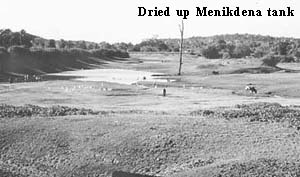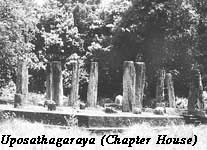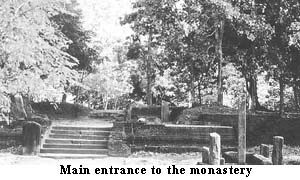 |
 8th March 1998 |
Front Page| |
Where river, lake and mountain meetA forgotten archaeological and nature reserve gets a new lease of life thanks to a dedicated 'Trinity' effort By Dr. Magdon Jayasuriya
The Menikdena Archaeological Reserve and Arboretum, as it is now called, is about two hours away from Kandy via Matale, Naula and Pannampitiya or three hours from Colombo via Kurunegala, Galewela and Pahalawewa.16 hectares (40 acres) of the archaeological reserve area consist of 2 hectares (5 acres) of a monastery square and about 14 hectares (35 acres) of luxuriant climax forest. Located between the picturesque Menikdena or Nikula hill range peaking at 865 m above sea level, with lush greenery, the blue waters of the Menikdena tank and silent plains, the Arboretum cum archaeological reserve offer much to the visitor. The sparkling waters of the Menikdena tank adds greatly to the beauty of the environment. It not only purifies the air, but also radiates coolness and the peripheral tree islands are home to many species of fish and birds. The dedicated and adventurous staff of Kandy's Trinity College was responsible for this magic. The Menikdena Project has taken the boys as their college hymn goes, "Where river, lake and mountain meet", and on "A path for youthful feet with life abounding". It has been sheer hard work through which the Trinity lads experienced the dignity of labour with the mammoties and pick-axes causing corns on palms which are more familiar with a rugger ball. I will not be wrong if I regard Sunil J. Madugalla as the main actor of the Menikdena drama. He is a senior staff member and the advisor of the Historical and Geographical Society of Trinity College - the man who initiated the Menikdena Development Project in 1994 and did much of the spade work involved.Today he works as the Project Director . Encouraged and supported by the college Principal, Lt. Col. Leonard de Alwis and other dedicated staff: the late L.B. Karunaratne,Hiran Kannangara, Messrs. J. Welianga, A.B. Jayasinghe, D.M. Samarawickrama and Asoka Bandara and G.L. Peter of the supporting staff, the Menikdena Project is a magnificent example for the other schools in Sri Lanka. "This is the first collaborative project of this kind to be undertaken between our department and any school in Sri Lanka," says the Director General of Archaeology, Dr. Siran U. Deraniyagala, who willingly approved the project. Director Architectural Conservation - Gamini Wijesuriya, the Director Excavations and Museums - W.M. Wijepala and M. Weerakkody the Regional Officer at the Kandy office of the Archaeological Department have also been supportive of this pioneering venture. Lakshman Jayakody, the Minister of Buddha Sasana, Cultural & Religious Affairs, an illustrious old Trinitian and Patron of the Menikdena Project calls it a "path-breaking venture which is an explicit and conceptually new move to heighten public awareness". Dr. Chandi Udugama, Lecturer in Archaeology at the Open University, who received a Trinity award in 1995 for the Exceptional Services rendered to the Menikdena Project, says the Menikdena Monastery dates back to the reign of King Kithsiri Mevan (6th Century A.D.) who was its architect. It served as an abode for recluses and arahants, thus earning the name Budugama, which later became Buthgama and finally Menikdena on account of nature's bounty in the formation of precious stones as legend has it. Though the recorded history of Menikdena dates back to the reign of King Kithsiri Mevan (555 - 573 AD), some Archaeologists are of the opinion that there is evidence to believe that the origins of the Monastery complex could date back to the 3rd or 4th centuries A.D. Records also indicate that Menikdena was used as a military base by King Vijayabahu I (1110 - 1111 AD) during his campaign against the Cholas and that it also served the same purpose during the campaign of King Parakramabahu I against King Gajabahu II (1132 - 1153 AD). A large camp site could be seen on top of the Nikula - Bibile hill above the Atha Bandi Wewa tank. Legend has it that the name 'Atha-Bandi' came into usage with the Royal Elephant of King Vijayabahu I having been rested there. With the decline and fall of the Polonnaruwa Kingdom, the Menikdena monastery too would have lost its glory, suffered loss of patronage and receded to a state of oblivion, partly because it was not a cave temple which was much in vogue in later times.
According to the leading archaeologists, these are no ordinary structures, but ones exquisitely planned according to classical standards of the time, a view endorsed by both Dr. Roland Silva and Dr. Prematilake in their treatises on "Vastu Vidya Sastra". This is one of the few monastic sites, where the vivid remains facilitate the identification of all five sacred structures already mentioned. I was invited by the college Principal in 1995 to look at the possibility of establishing an arboretum (tree garden). I was then the Curator of the National Herbarium, Sri Lanka's best plant library where facilities for plant identification are available. After Dr. Sarath Amarasiri, Director General of Agriculture approved and Mr. Bathiya Sumithraarachchi, Director of the Peradeniya Botanic Gardens facilitated the project, the Department of Agriculture became closely involved. Young Trinitians helped me most enthusiastically in the collection of specimens, sometimes even by tree climbing, numbering the trees with paint, fixing aluminium name boards high up on the tree trunks, laying of nature trails and cleaning the forest undergrowth when necessary. All these activities were ably coordinated by Dr. Hiran Kannangara whose interest and dedication was responsible for the successful completion of the arboretum component of the project in 1997. Nearly 500 tree labels for about 110 species within the 40 acre reserve were fixed. Each label indicates the scientific name of the tree, its family and the local names in Sinhala, Tamil and English. Endemic,(confined to Sri Lanka), indigenous (could also be naturally found in other countries) and introduced trees are labelled in different colours. In the case of introduced trees, the origins are also given. A board at the entrance to the arboretum gives a guide to the information contained in the tree labels. Therefore, the arboretum has been designed to provide the visitor an opportunity of self-learning. Menikdena fits too well into a definition of an arboretum: "a labelled collection of trees, naturally occurring or raised by people, which is displayed for educational, research and recreational purposes-its usefulness depends on the location, accessibility, representativeness, size and availability to be freely visited". Incidentally, Menikdena is the only arboretum portraying natural climax vegetation in the dry zone. (The Popham Arboretum at Kandalama, Dambulla represents various stages of secondary forest, established on degraded scrubland on old chena clearings, which in the future, will transform into dry mixed evergreen forest). The arboretum has the character of a forest which is normally found in the Intermediate Zone of Sri Lanka. However, the transition from the Dry Mixed Evergreen Forest, the typical forest type in the dry zone, to the Intermediate Forest is distinct and relatively abrupt. Groves of age-old Na trees near the streams, huge Milla and Kaluwara trees and serpentine lianas of Pus-wel meandering among the forest canopy add charm to the diverse flora and make it an ecological paradise. In 1997, we prepared a publication, Flora of Menikdena - Part I. This contains sketches of 25 selected tree species with non-technical information about each species with the help of students and National herbarium staff. A limited number of copies are still available at the college with Dr. Hiran Kannangara. Very soon this will be translated into Sinhala as many school teachers have requested this publication. As the project grew in stages, it was necessary to convince the Menikdena villagers of the goodwill mission and win their cooperation especially to protect the reserve. Several community development functions such as improvement to their housing, water- seal toilets, books and school uniforms have been donated to the residents in the immediate environs of the project area. Furthermore the culverts on the approach road were repaired and medical clinics were conducted. Employment and scholarships for the village lads are being contemplated.
|
||
|
More Plus * Stay cool in Grand style * Grand fun and frolic * French connection in perfumed isle
Front Page| News/Comment| Editorial/Opinion| Business| Sports | Mirror Magazine |
||
|
Please send your comments and suggestions on this web site to The Sunday Times or to Information Laboratories (Pvt.) Ltd. |
||
 Barely
four years ago, Menikdena was one of many archaeological sites, unknown,
unheard and unseen by many of us. It was left to the mercy of the weeds,
scrub jungle, termites,. vandals and treasure-hunters. However, today,
it is a splendid archaeological reserve, a biodiversity-rich nature reserve
and an arboretum due to the efforts of Trinity College.
Barely
four years ago, Menikdena was one of many archaeological sites, unknown,
unheard and unseen by many of us. It was left to the mercy of the weeds,
scrub jungle, termites,. vandals and treasure-hunters. However, today,
it is a splendid archaeological reserve, a biodiversity-rich nature reserve
and an arboretum due to the efforts of Trinity College. Among
the architectural highlights at Menikdena, there are the ruins of five
sacred structures : Pratimagara (Image House), Stupa (Relic Chamber), Bodhigaraya
(Tree Shrine), Uposathagaraya (Chapter House) and Dharmasalawa (Congregation
Hall).
Among
the architectural highlights at Menikdena, there are the ruins of five
sacred structures : Pratimagara (Image House), Stupa (Relic Chamber), Bodhigaraya
(Tree Shrine), Uposathagaraya (Chapter House) and Dharmasalawa (Congregation
Hall). Through
a brief period of just over three years, the original objectives of the
Menikdena Project have blossomed into very ambitious ventures. The monastery
square, which was once trackless and covered by scrub jungle and grass,
and strewn with termite mounds and forest debris, has been converted into
a levelled and beautifully landscaped tree park. The whole reserve, with
its meandering network of nature trails and the trees proudly carrying
their identity cards, is now a nature's botanical library. The project
activities have triggered the Archaeological Department in restoring five
main monastic monuments, the main entrance and some other monuments in
the forested area. A large building with a dormitory, staff and dining
rooms with water, cooking and toilet facilities has been constructed to
accommodate weekend groups of students and staff. The writer is Director,
Plant Genetic Resources Centre, Department of Agriculture
Through
a brief period of just over three years, the original objectives of the
Menikdena Project have blossomed into very ambitious ventures. The monastery
square, which was once trackless and covered by scrub jungle and grass,
and strewn with termite mounds and forest debris, has been converted into
a levelled and beautifully landscaped tree park. The whole reserve, with
its meandering network of nature trails and the trees proudly carrying
their identity cards, is now a nature's botanical library. The project
activities have triggered the Archaeological Department in restoring five
main monastic monuments, the main entrance and some other monuments in
the forested area. A large building with a dormitory, staff and dining
rooms with water, cooking and toilet facilities has been constructed to
accommodate weekend groups of students and staff. The writer is Director,
Plant Genetic Resources Centre, Department of Agriculture
